Immerse yourself in Córdoba's vibrant flavors and uncover hidden culinary gems with our expert insider guides. Plan an unforgettable trip today!
Read more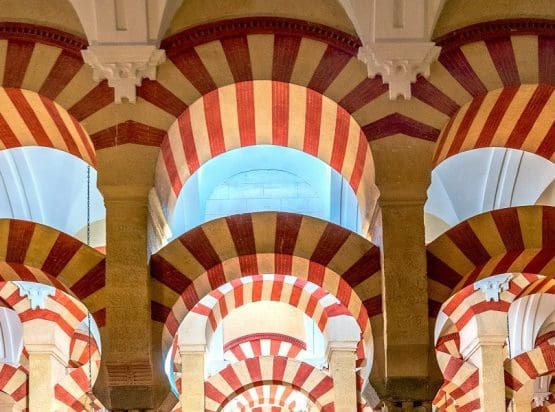
EXPLORE ALL OUR ANDALUCIA WINE REGIONS GUIDE
Last updated: August 15, 2024
Fifty years ago, Spanish brandy was rarely held in great esteem by cigar-chomping sybarites. Inexpensive to make and widely available, it had the texture of sandpaper and the finesse of an overcooked ham. Yet the drink was very popular with Spanish consumers in the mid-20th century, sold as an affordable tipple to get workers through their arduous days. Nevertheless, a generous assessment would describe the critical mass of Spanish brandies as “firewater.” Velvety, they were not.
However, the picture looks very different today. Amid the national wine renaissance, there has been a concurrent revitalization of the country’s spirit industry, with major investments raising the quality bar to new heights; this has been fueled by rising global demand for premium spirit brands. The chief Spanish beneficiary of this dramatic turnaround has been the Sherry Triangle – home of Brandy de Jerez. Over 95 percent of all Spain’s brandies are made in this beautiful region, the finest of which can compete with the long-aged Cognacs of France. A poor and lackluster relation to its French counterpart? Qué va! as they say in the tapas bars of Seville.
Discover more about Spanish Wine
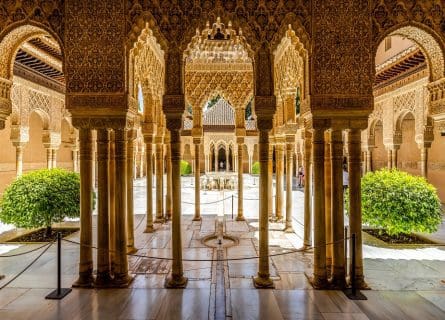
If ever there was a spirit with a spirited history, it’s Brandy de Jerez. The drink is produced in the Sherry Triangle (a geographical area between Seville and Cadiz), predominantly by the same companies that make and bottle this venerable wine style. Yet vines have grown in Andalucia since the Roman conquest in the 3rd century B.C. Overseeing a vast western empire that stretched from North Africa to England, the Romans encouraged the spread of viticulture throughout their provinces and territories. Baetica (modern-day Andalucia) was the jewel in their Iberian crown, a province rich in minerals and agricultural wealth. But, after the Western Roman Empire disintegrated in AD 476, all hell broke loose.
Historians refer to this post-Roman period as the Dark Ages; rival civilizations from northern Europe fought bloody and ferocious battles as they attempted to claim Rome’s lost territories for themselves. The Germanic Vandals established a short-lived base in Andalucia; however, they were displaced by the forces of the Moorish general Tariq. In 711, Tariq led an army of Arab and Berber mercenaries into southern Spain, where their superior might quickly vanquished all who stood against them. Within a few years, a Muslim Caliphate ruled most of Spain and Portugal, responsible for great advances in science, engineering, and architecture; Granada’s Alhambra Palace and La Giralda in Seville are among the most stunning examples of their cultural legacy. Yet a campaign to reconquer Spain from the Moors began earnestly in the Middle Ages, spearheaded by the Catholic Monarchs. The last major engagement took place in the 15th century, as Fernando and Isabel fought Boabdil for the city of Grenada. The former emerged triumphant, ejecting the Moors from their final stronghold in 1492. Spain was once again a fully Christian nation.
Yet the Moors must be given due credit for their pioneering work in distillation, a precursor to the emergence of Brandy de Jerez. Although the Moors had no interest in maintaining the vineyards of Jerez for wine production in the Middle Ages, they did advocate using distillation to obtain ethanol from the grape musts, used for medicinal purposes. Several centuries later, grape-based spirits were produced commercially in the southwestern corner of Andalucia. However, the first appearance of a modern incarnation of Brandy de Jerez wasn’t until the 19th century; like many great inventions, serendipity played a deciding role.
In that era, Dutch shippers purchased large quantities of high-grade Jerezano grape spirits to make their liqueurs called brandewijn, a name for “burnt wine” later transformed by the British into brandy. History records that an order for 500 barrels of raw spirit, called “Holanda” because of its destination, was placed with the firm that would evolve into Pedro Domecq. When the order wasn’t paid for, the fiery spirit was transferred into barrels previously used to store Sherry.
For five years, those barrels sat forgotten and untouched in Domecq’s cellars until one day, a still master found the barrels and pulled a sample out of curiosity. Immediately he noticed that the color of the Holanda had darkened from its normal water-like translucency, the aroma had enriched and taken on Sherry notes, and the burn of the raw Holanda had mellowed considerably. Almost immediately, Domecq seized upon formulating an alcohol reduction (adding distilled water worked best) and barrel-aging process for Holanda, and by 1874 the company was bottling a barrel-aged Brandy de Jerez called Fundador. Soon after, other companies followed suit.
Meanwhile, several British and Irish families founded Sherry Bodegas in the 19th century, although the advent of phylloxera was a major setback. This poisonous louse, accidentally imported from the U.S., destroyed vineyards across Europe in the late 1800s. The only solution was to regraft European varieties onto American rootstock: the main grape used to make Brandy de Jerez, Palomino, was widely adopted during the replanting program. This is because impoverished growers needed a high-yielding variety that was both sturdy and easy to grow. Palomino fitted the bill perfectly. Today the noble tradition of producing brandy from Sherry grapes continues apace as foreign markets become more amenable to premium grape spirits that don’t contain the word ‘Cognac’ on the label.
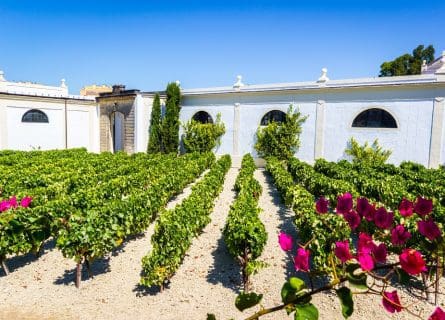
Brandy de Jerez is produced in the world-renowned Sherry Triangle of Andalucia. Encompassing the towns of Jerez de la Frontera, Sanlucar de Barrameda, and El Puerto de Santa Maria, the vineyards are planted on calcareous soils responsible for Sherry’s acidic ‘grip’ and structure. Indeed, the Albariza terroir of the central plain is the linchpin behind the entire Sherry industry; Palomino has developed a powerful synergy with these water-retentive and limey clay soils, while other areas always yield flabby and pale wines. Today, every grower agrees that the villages of Carrascal, Macharnudo, Anina, and Balbaina produce the finest grapes. Yet the sandy terrain that dominates vineyards further west is ideal for growing Moscatel. The climate is characterized by long, hot summers and mild winters. Between May to September, there is scant rainfall in western Andalucia.
However, many would argue that Brandy de Jerez is created in the cellar, not the vineyard. Visiting a Sherry Bodega is like taking a journey back through time: stroll through Jerez’s cavernous and cobweb-filled cellars, where you will see the 12-foot-high brandy soleras sitting elbow to elbow with barrels holding Sherry. The vaulted mosque-like bodegas of the old-school producers are all very well-ventilated. They also have sand floors, which can be wet down during the sweltering summers to ensure proper humidity and control the bodegas’ temperature. It is in these dark and cavernous spaces that the master blenders work their magic.
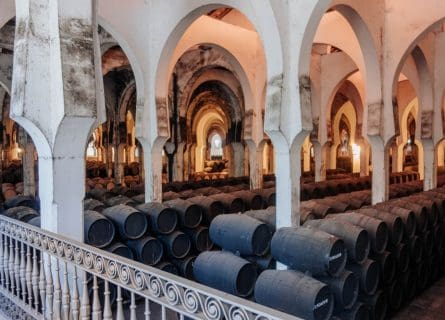
Producing Brandy de Jerez is a noble art that dates back to the 1800s. During that century, bodegas mainly used pot stills modeled on the alquitara stills left behind by their Moorish predecessors. Regrettably, contemporary economics requires that continuous column stills produce large quantities of high-alcohol distillate for entry-level brandies. However, The best bottlings are still derived from character-packed distillates from old-fashioned copper aquitards-stills that must be loaded with wine each time they’re used and cleaned out after every batch. This style of Brandy de Jerez, particularly the Solera Gran Reservas, is very much a hand-crafted product.
Historically, the grape for brandy distillation was the local Palomino, the same variety used for Sherry. However, producers of Brandy de Jerez have turned to the arid plains of La Mancha for their raw spirit. The grape they use is almost always Airén, an acidic, high-yielding white grape that is ideally suited to distillation. This process of heating the wine to increase its alcohol content (ethanol has a lower boiling point than water) takes place near the vineyards after the harvest. After that, the clear holanda (a wine distillate of about 65 percent alcohol) is transported to the Jerez region and put into large oak barrels. This potent eau-de-vie will be left in wood for several years, allowing the alcohol level to decrease as evaporation occurs naturally. At a certain point, the eau-de-vie will be diluted and matured in the same solera and criadera system used for Sherry.
This is the most vital stage in making Brandy de Jerez. Unlike Cognac or Armagnac, both of which spend some time in new French oak, Brandy de Jerez is aged entirely in 500-liter American oak barrels that previously held Sherry. The barrels are largely neutral and fairly porous, which allows for subtle oxidation and maturation, hence the dark color of many long-aged Solera Gran Reserva brandies. But wood maturation also imparts flavor and body. A barrel, once part of a fino solera, will impart a finer, leaner, sharper quality to the brandy, whereas a butt containing an Oloroso or sweet Sherry will impart richness. The strong characteristic of vanilla in the bouquet and on the palate results from the interaction between the alcohol in the brandy and the chemical compounds in the wood.
As with Sherry, aging is done in a dynamic solera consisting of multiple rows of barrels called criaderas. Each criadera contains brandy of a different age, with the youngest labeled criadera one and the oldest labeled criadera seven, eight, even 20 or 25, depending on how many criaderas the producer wants to maintain. When it is time to take brandy for bottling, a fraction of the oldest criadera’s contents is removed, sometimes as much as one-third. Somewhat confusingly, the oldest criadera is referred to as the solera, the same term applied to the whole aging system.
Once a portion of brandy has been removed from the criadera for bottling, spirit from the next oldest criadera is taken to replace what has been removed. That procedure is then repeated up the line, with, for example, a portion of criadera, two fortifying criadera three, and ultimately criadera one receiving a new batch of Holanda. The maturing spirit movement from criadera to criadera is why it’s called a dynamic aging system. The logic behind the solera system is that when a younger brandy is blended into an older one, the younger one acquires, the older brandy’s flavor and character. Aeration and accelerated oxidization also occur when the brandy is moved from one criadera to the next. The ultimate goal in solera aging is to create complexity, richness, and softness in the finished article – qualities that premium Brandy de Jerez shares with Cognac.
Can Brandy de Jerez tempt Cognac aficionados to switch sides? The initial reaction of the naysayers is to scoff – they balk at the very suggestion in a rather condescending way. Nevertheless, we must concede that while top-end Cognac labels are marketed as luxury commodities, Spanish brandy has traditionally been viewed as a more ‘democratic’ option. In a multitude of Spanish-speaking countries around the world and more casual settings like bars and nightclubs, Brandy de Jerez is frequently served as an everyday libation, usually on the rocks with Coke or ginger ale. This is hardly likely to tempt wealthy connoisseurs into the world of Spanish brandies.
Yet Brandy de Jerez is not a homogeneous category. At the top of the hierarchy is the Solera Gran Reservas, aged for a minimum of three years in used Sherry casks but typically for much longer, usually 10 to 15 years, with some components even older than that. Solera Reserva bottlings must spend at least one year in barrels, but they often age for two or more years in used Sherry butts.
Today much of the focus in the Jerez region is on the very best Solera Gran Reservas like Cardenal Mendoza from Sanchez Romate, Conde de Osborne, Lepanto by Gonzalez Byass, Gran Duque d’Alba from Williams & Humbert, Carlos I of Pedro Domecq, and Hidalgo 200 Gran Reserva. These bottlings stem from the highest-quality distillates and are worthy of comparison with an X.O. Cognac or an aged Armagnac. But they are far more affordable, with a price tag that hovers around $70 instead of over $1400 for Hennessy Paradis.
Of course, there are key stylistic differences between Spanish brandies and Cognac. The latter (certainly in the upper echelons) is defined by its exquisite perfume and unrivaled textural finesse rather than power and potency. In contrast, Solera Gran Reservas are often quite robust brandies, albeit you’ll discover great complexity in the older blends:
These rich brandies are often loaded with coffee, vanilla, and chocolate flavors. Yet they work very well as a post-dinner digestif, as top Brandy de Jerez is always balanced and fine.
Just ask yourself this question: what, exactly, are you paying for? A status symbol? A public declaration that you’re an oligarch? If so, order a bottle of Hennessy Paradis after dinner and make sure everyone sees you. Job done: you’ve got what you’re paying for. However, if the quality behind the label is your primary concern, why not explore the world of Brandy de Jerez the next time you’re in a Cognac mood? It may surprise – and delight – you at a fraction of the price.
Airen is a white wine grape widely cultivated in Spain's La Mancha region, known for its ability to thrive in hot and dry climates and produce light-bodied, crisp wines with fresh and fruity flavors.
Palomino: The quintessential grape for Sherry in Andalucia, Spain's southern delight. Unearth tradition's essence in every sip.
Find out moreAndalucian cooking nourishes the soul. It is a veritable melting pot of Roman, Jewish, Arabic, and New World influences; the Moors had the most dramatic impact on gastronomy in Jerez, introducing citrus, apricots, mint, aubergines, spices, and the delicious churrasco (barbecued meat). These wonderful ingredients will be used to spectacular effect in the main excellent restaurants of Jerez de la Frontera. However, many visitors prefer the lively atmosphere of a buzzing tapas bar. Not surprisingly, Sherry flavors many local dishes – try rabo de toro (oxtail) marinated in Amontillado.
Gastronomy of Andalusia: Read more

Immerse yourself in Córdoba's vibrant flavors and uncover hidden culinary gems with our expert insider guides. Plan an unforgettable trip today!
Read more
Immerse yourself in Granada's vibrant flavors and uncover hidden culinary gems with our expert insider guides. Plan an unforgettable trip today!
Read more
Immerse yourself in Jerez de la Frontera's vibrant flavors and uncover hidden culinary gems with our expert insider guides. Plan an unforgettable trip today!
Read more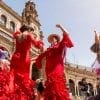
Immerse yourself in Seville's vibrant flavors and uncover hidden culinary gems with our expert insider guides. Plan an unforgettable trip today!
Read moreIf you would like us to customize an exclusive luxury tour, contact us and let us know your travel plans. We offer luxury food and wine tours for private groups of a mininium two guests. In addition, all of our private, chauffeured tours are available year-round upon request.

